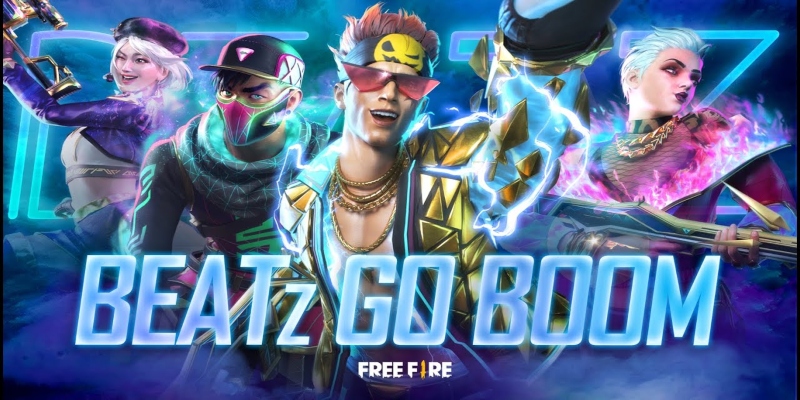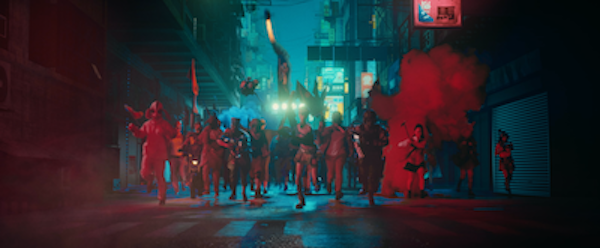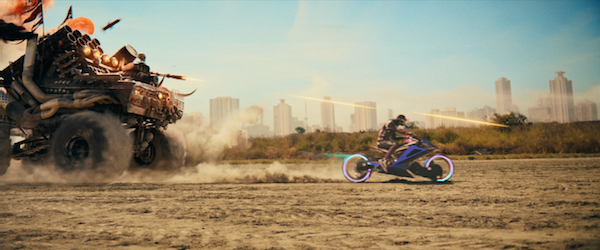
In the new music video for the global chart-topping mobile game Free Fire, live-action characters morph into digital heroes amidst extreme sports sequences, epic combat, and rhythmic dance-offs to the game’s Beatz Go Boom theme song. For the tight-knit team of skilled artisans at Amsterdam-based Post Panic, the in-house VFX studio at The Panics – music video production for the international battle royale phenomenon required developing highly stylized characters, vehicles, and environments and seamlessly meshing digital elements with photoreal plates. Under the direction of creative partner and head of production Ivor Goldberg, the team leveraged KitBash3D premium 3D assets as the building blocks for immersive environments, allowing artists to focus more resources on producing a standout final look.
Post Panic’s scope of work encompassed developing a massive digital cityscape environment to serve as an arena for the climactic battle sequence. The team conceptualised the environment in a Neo-Tokyo style reminiscent of a graphic novel, with a high enough level of photoreal detail to match live-action plates. The entire city needed to be viewable from an aerial point of view for establishing shots, as well as at a street level for shots zoomed in on the action. To help flesh out environment details, including buildings, streets, and alleyways, the team leveraged KitBash3D’s warzone and future slums model Kits to quickly block out virtual sets and expedite the process of creating scenes. Goldberg said, “Using KitBash3D gave us a huge head start. Once we blocked out the virtual sets, we were able to effectively go on a 3D location scout with director Mischa Rozema to create the shots that we needed. This allowed us to spend so much more of our time on the creative aspects of production and the final look, where it ultimately counts the most.”
Post Panic used a combination of Houdini, Maya, and Blender for modelling, rigging, and animation; Nuke for compositing and editorial; and Redshift for rendering. Goldberg stated, “KitBash3D assets were easy to bring into any of our creative tools and get started right away. We primarily used Blender at the conceptualisation stages, and we were simply able to import the Kits, update or tweak the shaders wherever necessary to achieve our desired look, and then adjust the geometry to match the style and composition. For final look development, we had to convert the KitBash3D model shaders into Redshift shaders and then add all the details in the textures, shaders, and geometry so that they’d hold up for the close shots and overall visual style. Working with KitBash3D assets provided us with the perfect base for every shot.”
In addition to the cityscape, Post Panic was tasked with developing the hero characters and enemy opponents, which required both digital head replacements for live actors and creating fully CG characters in the same graphic novel style as the project environment. While game publisher Garena provided existing assets for some of the game characters, the team still needed to rebuild the models and shaders to align with the high level of detail and realism in the music video production. Adding to the challenge, the character designs from Garena were still in development and required changes while Post Panic was creating the project models. Goldberg added, “The sheer range of work on this project was lunacy and required bringing together so many different elements. We were also in charge of creating CG monster trucks, explosions, mopeds that morphed into stylistic hyperbikes, rockets, grenades, crowds of charging enemies, disintegrating characters, collapsing buildings and environment destruction, parachuting, abseiling, and a healthy amount of dancing.”
Despite a massive post-production workload and tight deadlines, using KitBash3D as the building blocks for the environment helped the team to deliver on time. “By using high-end assets from KitBash3D, we were able to use our time and budget more wisely and get to the final image in the fastest and most efficient way. Rather than building every single element, we’re able to customise and focus our time on making the end result look great,” said Goldberg.
Goldberg concluded by saying, “The sheer scope and range of the project, along with the seemingly contradictory contrast in visual aesthetics between highly stylised and photorealism that had to seamlessly work together presented a major challenge. Pair that with a shrinking production timeline, and it was a daunting undertaking. Despite the scale of the project, with the help of KitBash3D, we were able to flesh out the worlds quickly, which ensured this project was genuinely fun from beginning to end.”


